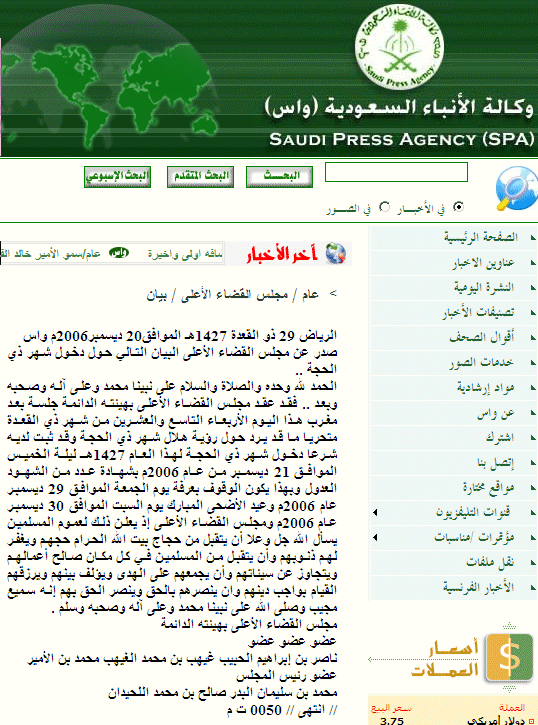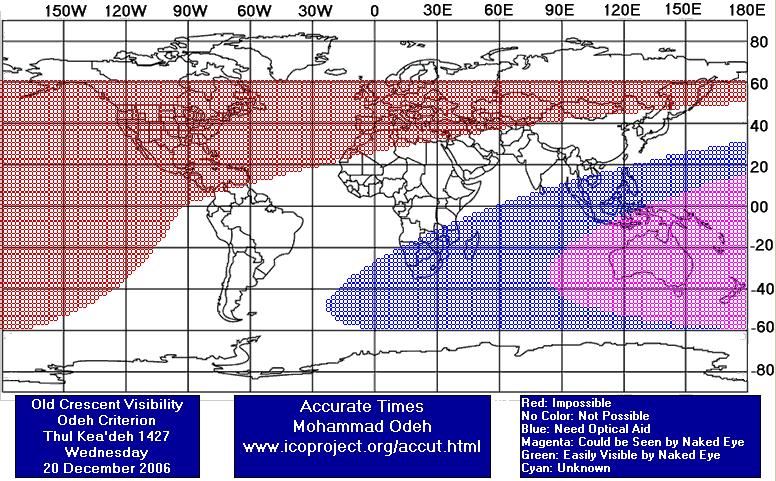Visibility of Thul Hijjah Crescent
(1427 AH)
- When to Observe Thul Hijjah Waxing (NEW) Crescent ?
- Thul Hijjah Waxing (NEW) Crescent Observation Results
- The OFFICIAL First Day in Different Countries
- Saudi Will Look For the Crescent On 28 Thul Keadah!
- ICOP Official Statement
- ICOP Official Statement (Comment on Thul Hijjah Beginning)
- Saudi Announces; Thul Hijjah Starts on Thursday and Eid on Saturday!
- When to Observe Thul Keadah (OLD) Crescent ?
- Thul Keadah Waning (OLD) Crescent Observation Results
The geocentric conjunction (Geocentric New Moon) will occur Inshalla on (Wednesday 20 December 2006) at
14:01 UT.
Sighting the new crescent on (Wednesday 20 December 2006) and on (Thursday 21 December 2006) is shown in the below graphs using the program Accurate Times by Mohammad Odeh according to Odeh criterion. Where:-
According to the actual sighting of the crescent, the start of Thul Hijjah should be on Friday 22 December 2006 in almost all the world and hence Al-Eid should start on Sunday 31 December 2006.
As for South America, Thul Hijjah should start on Thursday 21 December 2006 and the start of Al-Eid should be on Saturday 30 December 2006.
- Results of seeing the crescent, and the first day of the month in different countries will be added here Inshalla as we receive the reports from ICOP's members. If you wish to be a member in ICOP, or to know more about it, kindly click here.
So far, the earliest sighting of the crescent was on Thursday 21 December 2006 from Australia, the crescent was also seen on this day from: UAE, Iran, Kuwait, Saudi Arabia, Algeria, Nigeria and USA.
Wednesday 20 December 2006:
Thursday 21 December 2006:
"From: The Astronomy and Geophysics Centre Of Shahreza
The reporting of new moon crescent observation of Thul Hijjah
We could see this crucial new moon crescent at Dec. 21 .2006 (30/9/1385according to Calendar of Iran), On Thursday night in a region located 40 kilometers far from shahreza to Semirom called khorusgelu with these location parameters:
The region was covered with snow and group surprised with very cold weather and snow to the knee that resulted in not to take a beautiful picture from the crescent. There was no cloud in the sky and the west horizon was covered with about 2 degrees from dust.
- Our equipment:
Population of our group: 26 persons
-Sun rise according to software: 17:03
- The first observation of crescent parameters:
The group was divided two and all of them observed the crescent.
It is notable we tried but the crescent was not visible to the naked eye.
The group members:
Pictures are attached"
Thursday 21 December 2006:
Friday 22 December 2006:
Saturday 23 December 2006:
Surprisingly Saudi announced officially that they will look for Thul Hijjah crescent on Tuesday 19 December 2006 (28 Thul Keadah even in Saudi). They are explaining this because there was only one single witness who 'saw' Thul Keadah crescent at the beginning of Thul Keadah! It is truly a disappointing decision to know that Saudi will look for the crescent on Tuesday when it is eventually impossible to be seen even on Wednesday! Where the crescent will set BEFORE the Sun in Saudi on Wednesday! Consequently, they shouldn't ask for crescent sighing even on Wednesday! Moreover, seeing the crescent by naked eyes from Saudi on Thursday is very difficult. So it is truly very strange to ask for crescent sighting two days before the actual sighting date!
It is worth mentioning that Saudi is saying that the crescent of Thul Keadah was seen by a witness on Monday 20 November! On that day the Moon had set before Sunset in all the Islamic World! Actually in almost ALL the world!
Even though the crescent was not in the sky, Saudi has announced that there are persons who saw the crescent on Wednesday 20 December 2006, and hence the start of Thul Hijjah is Thursday 21 December 2006, and Al-Eid will begin on Saturday 30 December 2006. This is not the fist time Saudi claims seeing the crescent when the Moon is NOT in the sky! Kindly find below the Saudi official statement.
The geocentric conjunction (Geocentric New Moon) will occur Inshalla on (Wednesday 20 December 2006) at
14:01 UT.
Sighting the OLD crescent on (Wednesday 20 December 2006) is shown in the below graph using the program Accurate Times by Mohammad Odeh according to Odeh criterion. Where:-
Wednesday 20 December 2006:
When to Observe Thul Hijjah Waxing (NEW) Crescent ?



Thul Hijjah Waxing (NEW) Crescent Observation Results
Date: THU December 21, 2006.
Location: Esfahan, Iran (32:37N 51:35E).
Time Zone: +3.5. Observer: Alireza Mehrani.
The western horizon was hazy & partly cloudy.
Sunset: at 16:57(LT).
The first crescent observation by 15x80 binoculars: at 17:16 (LT).
Arc Length: 105 (2-5.5).
The Last crescent observation by 15x80 binoculars: at 17:25 (LT).
Reporter: Hossein Janghorbani, manager of the center
This Centre is located in Iran, Isfahan, Shahreza)
Lat: 31° 38' N
Lon: 51° 42' E
Ele: 2581 m
Tz: +3.5
two binoculars 15 × 70 installed on tripod
one binoculars 30 × 60
one compass
-Sun rise observed: 16:56
By: Ali Janghorbani
Through: 15x70 binocular
Time: 17:14 LT
Moon Alt: 3.890
Elongation: 12.537
1. Hojjatollah Khayyami
2. Rahmatollah Saheban
3. Omidali Kazemi
4. Hussein Arefan
5. Mohammad Ziyai
6. Mojtaba Dehghan
7. Seyyedmohsen Mirtaleb
8. Mohammadjavad Nikeghbal
9. Reza Janghorbani
10. Ali Janghorbani
11. Hossein Janghorbani
12. Nasrin Karimi
13. Nafise Karimi
14. Farimah Gerami
15. Shakiba Sabzevari
16. Maede Kamyabi
17. Mina Kamyabi
18. Moniresadat Mirtaleb
19. Zahra Parsaniya
20. Maryam Parsaniya
21. Nasjm Yusefi
22. Marziye Fallahi
23. Elham Forudi
24. Mandana Rezaiye
25. Parisa Naderi
26. Andishe Mirzai
Thursday 21 December 2006 Click on the Photo for Larger View 

By ICOP member Mr. Hossein Janghorbani.

The OFFICIAL First Day in Different Countries

Saudi Will Look For the Crescent On 28 Thul Keadah!


ICOP Official Statement

ICOP Official Statement (Comment on Thul Hijjah Beginning)

Saudi Announces; Thul Hijjah Starts on Thursday and Eid on Saturday!


When to Observe Thul Keadah Waning (OLD) Crescent ?


Thul Keadah Waning (OLD) Crescent Observation Results





